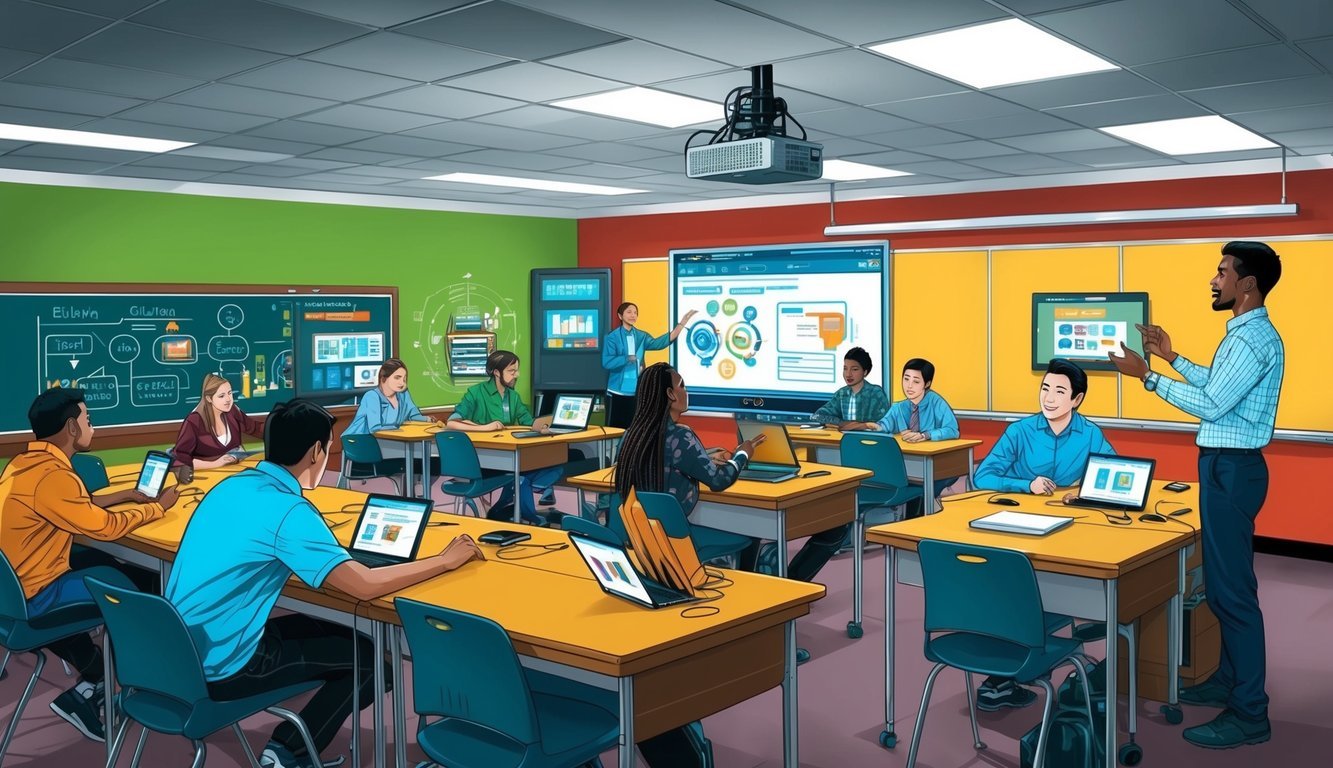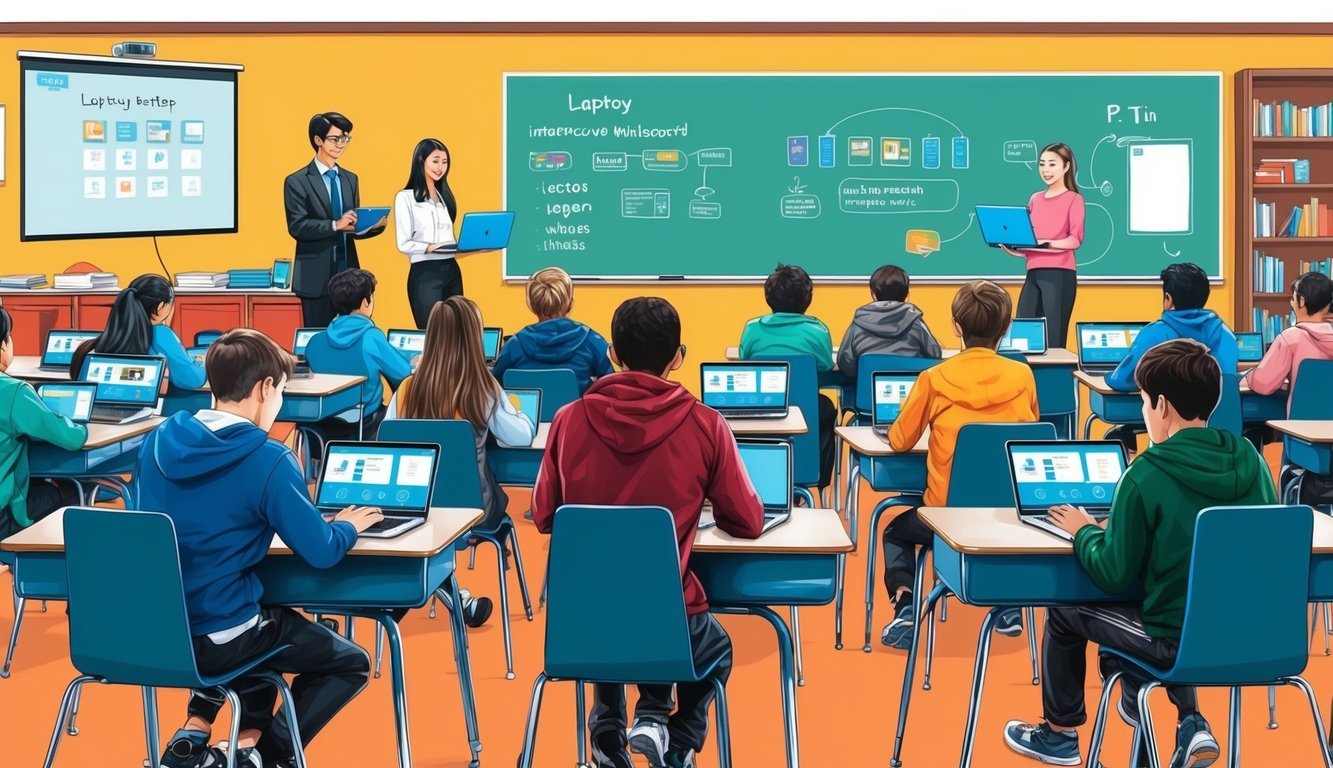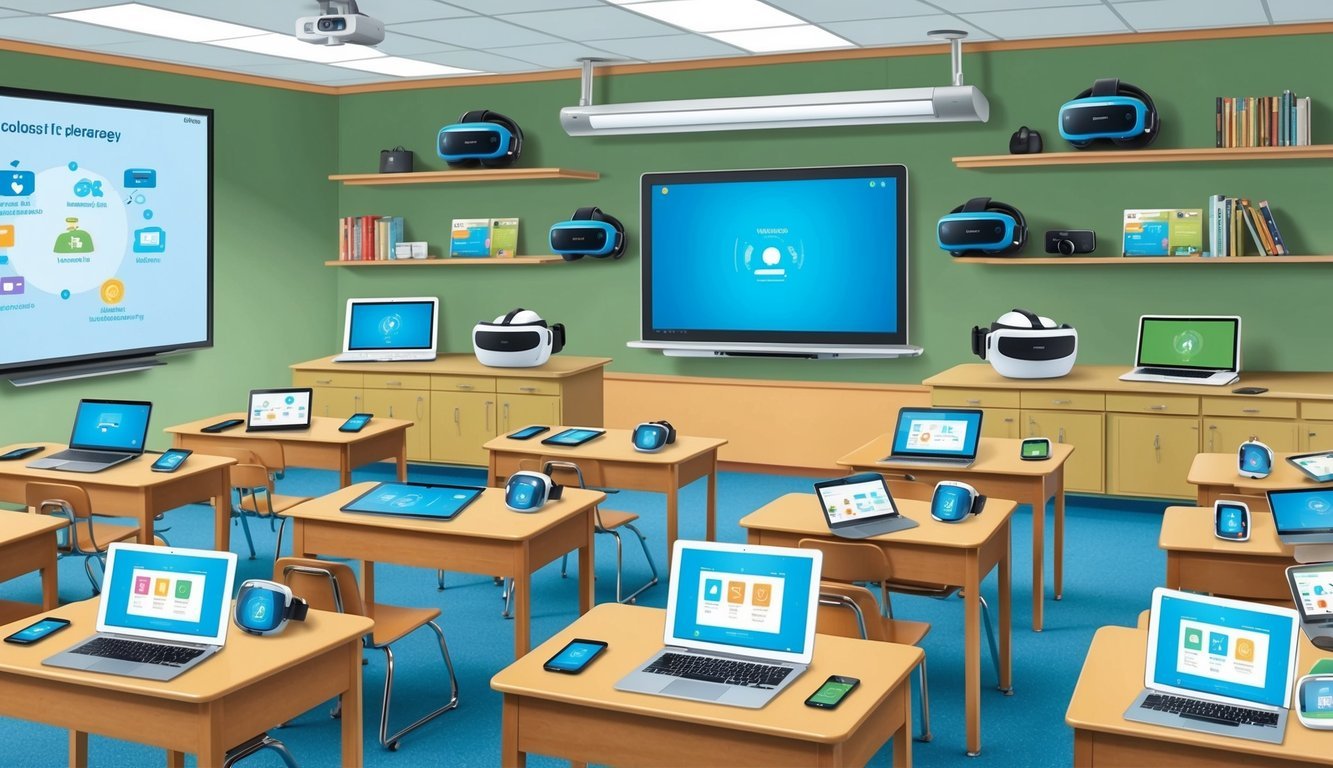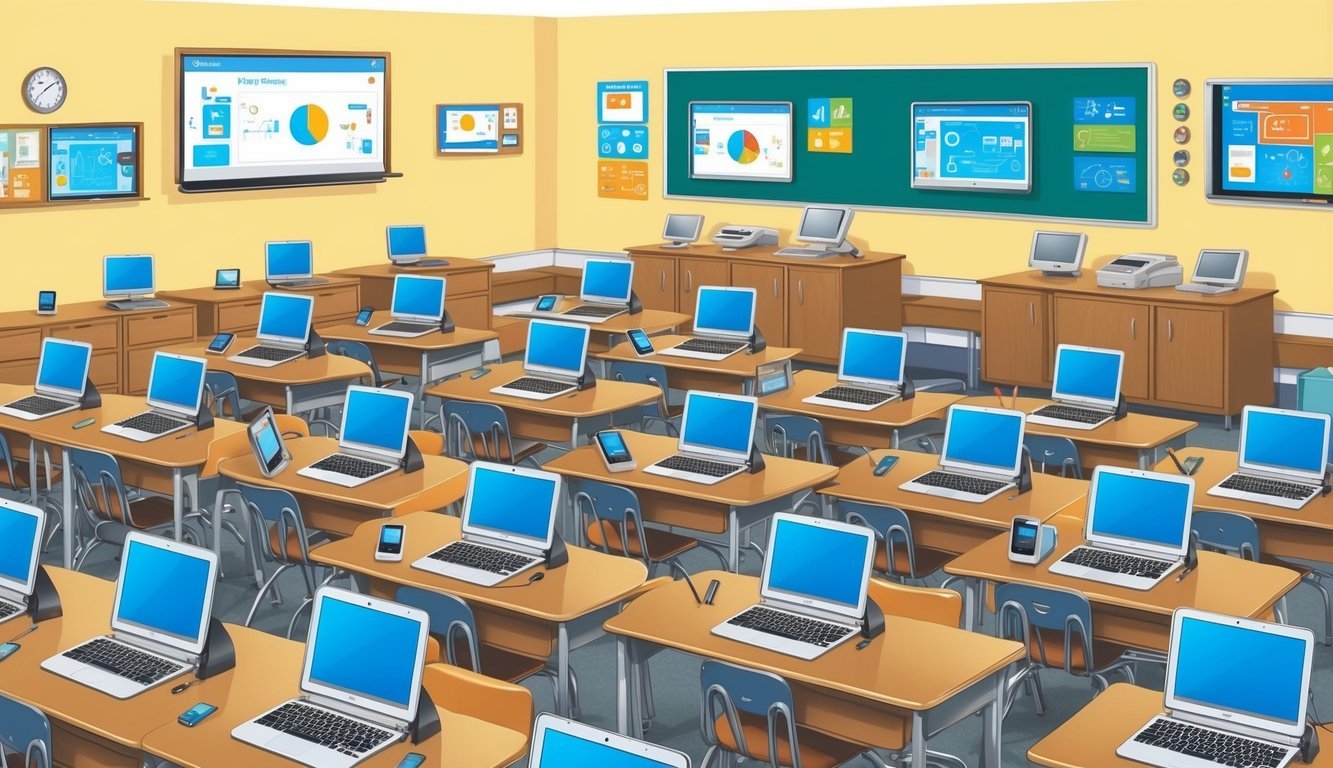“`xml
Ready to take your teaching to the next level with some cool tech? Educational technology integration courses can help bring your classroom into the digital age.
These programs are all about using nifty gadgets and software to make learning more enjoyable and effective for your students.
If you dive into an ed tech course, you’ll gain skills that can open doors to new career paths in areas like K-12 teaching, adult education, and corporate training. Whether you want to refresh your teaching style or make a major career shift, there’s a world of options available.
Let’s take a look at some exciting educational technology integration courses that can really boost your tech skills.
1) Teach with Tech: Integration Basics
Feeling overwhelmed with where to start using tech in your classroom? The Technology Integration For Educators course is just the ticket.
It’s designed for K-12 teachers who might be new to the tech game.
You’ll get to know the latest trends in education and some amazing tools to engage your students.
Plus, it dives into different approaches to help you plan tech-savvy lessons.
Don’t sweat it if you’re not a tech whiz! This course starts with the basics and builds up from there.
You’ll get hands-on experience with various technologies and learn how to choose the right ones for your classroom.
By the end, you’ll be ready to sprinkle more technology into your teaching—think engaging activities that your students will love! Plus, you’ll find some tools that save you time and simplify your work.
No more tech fears! Jump into this course and become that awesome teacher everyone looks up to.
Your classroom will feel fresh and exciting!
2) Blended Learning Mastery

Want to mix online and in-person teaching? Blended learning is where it’s at! It’s one of the hottest topics in education right now, with great courses to help you become a pro.
The Online Learning Consortium offers a Mastery Series that’s perfect for teachers.
You’ll discover how to use tech to get your students more involved.
Looking for something that won’t break the bank? Check out the Modern Classrooms Project.
They focus on blended instruction, letting students learn at their own pace while mastering skills.
Many teachers have found it super helpful.
Coursera also has a great option with their Blended Learning course.
You’ll learn how tools like Tableau can give your students hands-on learning experiences.
These courses help you blend online learning with face-to-face teaching like a champ.
You’ll pick up how to use videos, tech tools, and in-person time to make your classes more vibrant and effective.
3) Digital Storytelling Strategies
Want to jazz up your lessons? Digital storytelling could be the perfect solution! It’s a fun way to mix tech and teaching and get your students excited about learning.
There are digital storytelling courses that show you how to create amazing stories using digital tools.
You’ll learn to write scripts, create storyboards, and edit videos with user-friendly software.
Have you thought about using video to teach? Digital storytelling makes it easy.
You can create mini-documentaries or interactive stories to break down complex topics.
What’s awesome is that it works across all subjects.
Whether you’re teaching history, science, or even math, there’s a digital storytelling method to fit your lesson.
The courses also guide you on how to get your students involved in creating their own digital stories—what a great way to assess their understanding!
And don’t sweat it if you’re not tech-savvy. Many courses start off gentle and walk you through it all step-by-step.
You’ll be a digital storytelling whiz in no time!
4) Flipped Classroom Workshop

Want to shake things up in your teaching? A flipped classroom workshop might be just what you need.
It turns traditional teaching on its head.
In a flipped classroom, students explore new content at home, whether through videos or readings, while class time is devoted to hands-on activities and discussions.
You’ll learn how to create engaging content for students to use outside of class, like making videos or curating excellent online resources.
Don’t worry, it’s not rocket science!
During the workshop, you’ll discover effective ways to use class time—the focus shifts to collaborative projects, debates, or solving problems together.
You’ll also get tips on how to motivate your students, as this method relies on them doing their homework ahead of class.
The workshop offers strategies to keep them engaged and excited!
By the end of it, you’ll be ready to flip your classroom for the better.
Your students will appreciate the change, and who knows, you might just rediscover your passion for teaching!
5) EdTech Tools for K-12
Hey there! Let’s take a moment to explore some fantastic tech tools for K-12 classrooms.
These gadgets and apps can really make lessons more fun and interactive.
Meet FlipGrid, a video platform where students can share their thoughts and ideas with classmates.
It’s perfect for discussions and presentations.
Canvas is another gem.
It’s a learning management system that helps you keep track of assignments and grades with ease.
Want to get creative? Check out Storybird.
You can write and illustrate your own stories online, giving students a fun outlet for their creativity.
AutoDesk offers a range of software tools perfect for STEM subjects, allowing students to dive into the world of 3D design and engineering.
These tools can transform the learning experience, allowing students to dive into new ideas and work on projects in exciting ways.
Just remember, technology is a support in education, not a replacement for traditional methods.
6) Classroom Management with Tech

Want to keep your students focused and engaged while they use technology? A solid classroom management course can have a huge impact.
These courses cover setting rules and routines for tech use.
You’ll learn handy tips for monitoring screen time and keeping kids on track.
Some courses even dive into apps that allow you to manage student devices right from your computer.
The Classroom Technology Integration program at Fairfield University gives hands-on experience with the latest classroom tech tools.
You’ll discover ways to use technology that enhances teamwork rather than distracts from it.
If you’re looking for more options, check out Educators of America.
They focus on tech training tailored to help teachers and schools boost student success.
The key is balance.
You want to use devices effectively to support learning without letting them be a distraction.
The right course can give you the skills to strike that balance.
7) Gamifying Education

Want to spice up learning? Gamification is a fantastic approach that adds game-like elements to education, making it much more engaging for students.
Curious about how to gamify your classroom? Check out the Gamification course on Coursera.
You’ll learn how to apply game design principles in non-game settings.
Want to see it in action? The Gamification in EdTech course provides real-world examples of gamified learning, showing how it can boost motivation and engagement.
Ready to level up your teaching? Dive into the Gamifying Education course.
It covers the basics of game-based learning and how to implement it effectively.
Thinking about using your learning management system for gamification? Check out the 10 Ways to Gamify Your Classroom with an LMS.
It’s packed with practical tips to make your online courses more interactive and fun.
Benefits of Educational Technology Integration

Bringing tech into education opens up a world of exciting learning possibilities.
It not only makes classes more engaging but also allows for personalized lessons.
Enhanced Engagement
Tech integration turns learning into a more interactive experience.
You’ll find virtual reality tours and online quizzes that really capture attention.
Games and apps can transform dull subjects into exciting challenges.
Imagine solving math problems to save a virtual world or experiencing history through an interactive timeline.
Videos and animations help clarify complex ideas.
Instead of simply reading about how plants grow, picture watching it unfold in a time-lapse.
Group projects become a breeze with online tools, allowing collaboration on shared documents and chats—even from home.
Personalized Learning
AI-driven systems help tailor lessons to your unique learning style.
They adapt based on how you learn best, ensuring you’re neither bored nor overwhelmed.
You’ll get instant feedback on your work, cutting out the wait for grades—no more guessing what you need to improve.
Online courses let you explore topics that spark your interest, not just what’s available at school.
Tech also helps teachers identify where more support is needed, ensuring they can offer help tailored to individual struggles.
You can review lessons anytime, too.
Forgot something from class? Just pull it up on your device and refresh your memory.
Strategies for Effective Integration

Tech tools add a layer of fun and interactivity to learning, but it’s essential to use them wisely to truly enhance student learning.
Leveraging Interactive Tools
Interactive whiteboards are a fantastic way to get everyone involved.
Use them for group brainstorming or tackling problems together.
Digital quizzes and polls can check student comprehension in real-time, giving immediate feedback.
How about using virtual reality tools for field trips or science experiments? It’s like transporting your class to another world without ever leaving the room!
Gamification makes otherwise tedious topics exciting—think of turning lessons into quests or competitions.
The goal should be to enhance learning through tech so it’s a hands-on experience, not just a gimmick.
Collaborative Platforms
Online collaborative spaces are invaluable. Google Workspace for Education is a crowd favorite, allowing students to work together on documents, slides, and spreadsheets in real time.
Discussion forums are perfect for class debates or sharing thoughts, while video chat tools can connect your classroom with experts or peers around the globe.
Project management tools can teach essential teamwork skills, helping students plan, assign tasks, and track progress on group projects.
Just remember to choose tools that align with your lesson goals.
Make sure they’re user-friendly for students and won’t create more headaches than they solve.
Frequently Asked Questions

Tech integration in education raises a ton of questions.
Let’s tackle some common ones about models, courses, and programs that can guide you through this exciting field.
What’s the SAMR model all about in tech integration?
The SAMR model helps teachers level up their tech use.
It breaks it down into four levels: Substitution, Augmentation, Modification, and Redefinition.
This model illustrates how tech can elevate learning from simple tasks to completely new experiences.
Can I find free educational technology integration courses?
Absolutely! Many platforms offer free courses on ed tech integration.
Coursera has excellent options like Introduction to EdTech from EDHEC Business School.
Don’t forget to look for free trials or audit opportunities for paid courses!
How do I choose between different types of tech integration in my curriculum?
Pick what aligns with your teaching goals.
Think about what your students really need.
Want to make lessons more engaging? Try digital storytelling.
Need to save time? The flipped classroom could be your answer.
Always start with learning objectives, then find tech solutions that fit those goals.
Are there master’s programs focused on educational technology?
You bet! Many universities offer master’s in ed tech.
For example, Louisiana State University offers an online Master of Arts in Education with a focus on Educational Technology.
It’s flexible, and you may not even need GRE scores to apply.
Could you explain the five levels of technology integration in the curriculum?
The five levels are Entry, Adoption, Adaptation, Infusion, and Transformation.
At Entry, you’re just getting started.
By the time you reach Transformation, tech is an integral part of your teaching strategy.
Each step takes you further along your tech journey.
Where can I look for educational technology programs near me?
Start by checking out local colleges and universities—they often have ed tech programs available.
For instance, Michigan State University has a fantastic online certificate in Educational Technology.
And don’t overlook online options; they can be just as valuable as in-person programs!
“`

